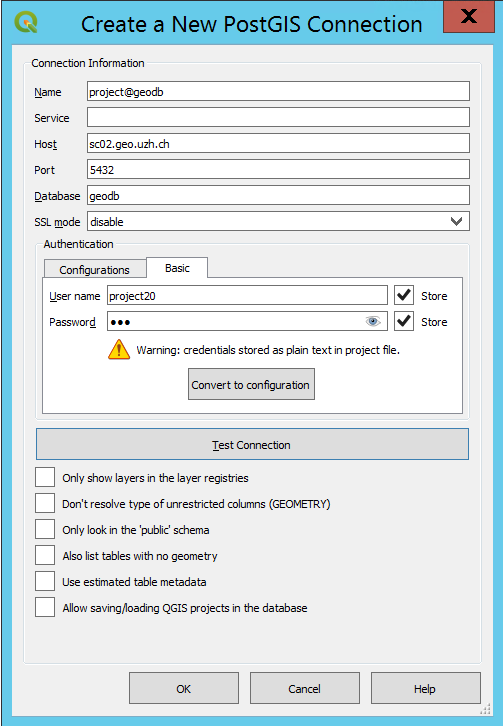FAQ - Databases and SQL
Everything related to database and SQL principles
Recommendations
1) Use lower letters for creating objects in a PostgreSQL database
- Use lower case letters for objects in PostgreSQL like tables, columns, triggers, keys, actually any object. Enter lower case in GUI environment, too. Otherwise objects like tables are created with partial uppercase letters! In this case double quotes are 'automatically' used while creating the objects and you have to use double quotes for querying, too! See Reuven Lerners blog.
2) No special characters - No reserved keywords for object names in a database
- Special characters such as ä, ü, -/+ etc. should not be used in table names, column names, view names and key names (generally object names). In contrast, special characters are allowed to be used in comments on tables or columns. Obviously the contents of text columns (varchar) in the database may contain special characters of any kind.
- Databases have keywords for internal usage and also for querying purposes. Examples are VARCHAR, NUMBER, LIMIT, SELECT, FROM, .... Do not use these names as table names, column names, view names and key names (generally object names). Keywords are normally marked with special colour while typing its name in a SQL-window. PostgreSQL documentation.
3) Put comments to all your tables and all your columns
- Minimal documentation (=metadata) of your tables and their columns is a de-facto standard in each database. For columns we use square brackets to indicate a unit, a code or in some cases a datatype if applicable. For sequences or identification numbers empty brackets are common.
4) Name your primary keys, foreign keys or spatial indices with a constant speaking name pattern
- Minimal documentation (=metadata) of your tables and their columns is a de-facto standard in each database. For columns we use square brackets to indicate a unit, a code or in some cases a datatype if applicable. For sequences or identification numbers empty brackets are common.
Modelling
In our tree table we have a categorical attribute which is a color component (red, green blue). Shall we write the text values in a text-column or encode the text values with numbers?
- It is recommended to encode categorical text values with numbers. You then actually treat the color as a separate entity type. This entity type will en up in the DB as a separate table (lookuptable) named 'color' with a primary key field e.g. COLNR (number) and a text column e.g. COLTXT. The tree table has a COLNR field as well. This field refers to the color table over a foreign key making sure that you can only fill in valid color numbers.
SQL Spatial Questions
Which SRID/geometry type have geometries stored in a spatial table?
What is the unit for a specific projection/SRID?
How can I change the table columns' geometry type as well as reproject the geometries stored in the table?
- Example: Reproject a spatial table (mytable) with a subtyped column named geom of type geometry(MultiLineString,21781). This is projection CH1903 LV03.
- The column wille get a new subtype - a new SRID, respectively
- All records (geometries) inside the table get reprojected
- This converts all to CH1903+ LV95
- Check the geometry column datatype of your table now as described on this page 'Which column datatypes or subtypes exist in a table?'
SQL General Questions
Which datatypes should I use for tables in PostgreSQL with PostGIS?
- We recommend the follwing ones that cover all datatypes we usually need
Which column datatypes or subtypes exist in a table?
- Listing existing columns of a table
Can we automatically count up an identification field in a table?
- Yes. While creating a table choose for your id field the serial field type (~data type). (rm) What happens behind the scenes? The field idfield actually is generated to contain the integer data type. Additionally a sequence 'mytable_idfield_seq' is automatically generated for counting up the values. As soon as we insert a record into table mytable the idfield gets filled with the next value of the sequence.
How can I retrieve a limited number of rows in a SELECT Query?
- Yes. Use the LIMIT clause.
Some GUIs like SQL Manager for PostreSQL limit returning records automatically in the background. They add additional SQL-Code to your SQL sentence. You can change such restricting values in the preferences of those programs.
How can I grant or revoke a table to a different user?
- Yes. Use the LIMIT clause.
Some GUIs like SQL Manager for PostreSQL limit returning records automatically in the background. They add additional SQL-Code to your SQL sentence. You can change such restricting values in the preferences of those programs.
How difficult is it to store files in the DB (e.g. .pdf, .docx, .wav or others)?
- Somewhat complicated in PostreSQL. Have a look at this documentation.
QGIS connection to PostgreSQL/PostGIS
How can I connect from QGIS to a PostGIS database?
- In the Browser Panel of QGIS -> Rightclick PostGIS -> New Connection
- Configure your connection accordingly

- To check your credentials: Test Connection
- You can use this connection either for browsing your spatial database objects or for loading spatial datasets (layers) to PostgreSQL/PostGIS
DBeaver
Configure new background to visualize your geometries on top
- If you run a SQL-Statement on one of your spatial tables like this: SELECT b.id, b.geom FROM userxx.imp_biogeo b; you can click on the resulting geom-column to visualize your geometry.
- You can use OpenStreetMap as a background map or define your own services
- Swiss Maps are available by entering the services in the DBeaver's Value-window -> Map-dropown -> Manage -> Add
Label: CH-25 Layer definition: 'https://wmts20.geo.admin.ch/1.0.0/ch.swisstopo.pixelkarte-farbe-pk25.noscale/default/current/3857/{z}/{x}/{y}.jpeg', {attribution:'CH-1:25', id:'ch.swisstopo.pixelkarte-farbe-pk25.noscale'}or this generalization:Label: CH-1000 Layer definition: 'https://wmts20.geo.admin.ch/1.0.0/ch.swisstopo.pixelkarte-farbe/default/current/3857/{z}/{x}/{y}.jpeg', {attribution:'CH-1:1000', id:'ch.swisstopo.pixelkarte-farbe-pk1000.noscale'}
Other Material
Can a PostreSQL database be accessed via PHP or other programming languages?
- Yes. Use the corresponding connection classes, mostly jdbc [java database connector]. (rm)
Errors
- Solution: